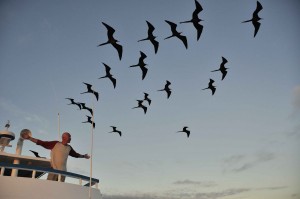

Males mate every breeding season and females breed every other year. Magnificent frigatebirds are serially monogamous and form pairs each breeding season. Magnificent frigatebirds are usually silent in flight, but make various rattling sounds when near the nests.

On land, they perch in low trees and shrubs or often spend time sunning themselves holding up their wings towards the sky. Magnificent frigatebirds are gregarious but often fly singly. After forcing the other seabird to regurgitate its meal, they will dive and catch the prey before it hits the surface of the water. They harass other seabirds to force them to disgorge their meals. Magnificent frigatebirds are also well-known for stealing prey from other birds. These acrobatic hunters don't swim or dive they are able to catch flyingfishes or squids right in the air when they leap out from the water. They are masters to use different methods to catch their prey without getting wet. Magnificent frigatebirds are unable to land on the water as their feathers are not waterproof.

Due to their small feet along with short legs these birds can barely walk on the ground. They are graceful and agile in flight but very clumsy on land. Magnificent frigatebirds are diurnal seabirds and spend most of their time soaring over the ocean, searching for food. Frigatebirds feed on fish taken in flight from the ocean's surface (often flying fish), and sometimes indulge in kleptoparasitism, harassing other birds to force them to regurgitate their food. The female is slightly larger than the male and has a white breast and belly. The male has a striking red gular sac which he inflates to attract a mate. The magnificent frigatebird is a large, lightly built seabird with brownish-black plumage, long narrow wings and a deeply forked tail. There are also populations on the Galápagos Islands in the Pacific and the Cape Verde islands in the Atlantic. It occurs over tropical and subtropical waters off America, between northern Mexico and Perú on the Pacific coast and between Florida and southern Brazil along the Atlantic coast. With a length of 89–114 centimetres (2 ft 11 in – 3 ft 9 in) and wingspan of 2.17–2.44 m (7 ft 1 in – 8 ft 0 in) it is the largest species of frigatebird. The magnificent frigatebird ( Fregata magnificens ) is a seabird of the frigatebird family Fregatidae.


 0 kommentar(er)
0 kommentar(er)
